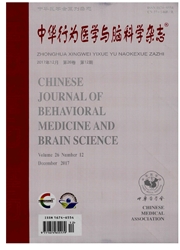

 中文摘要:
中文摘要:
目的观察大鼠海马内注射外源性脑源性神经营养因子(Brain-derived neurotrophic factor,BDNF)后对卒中后抑郁模型大鼠行为学的影响。方法经旷野试验(open-field test)评定后,共筛选24只符合人组条件大鼠,随机分为4组:PSD组,PSD注射生理盐水组,PSD注射高剂量BDNF组,PSD注射低剂量BDNF组,每组6只。大脑中动脉阻塞(MCAO)法建立局灶脑缺血模型,联合应用慢性不可预见温和应激(CUMS)结合孤养法,建立PSD大鼠模型。在应激第3天定向大鼠海马内注射BDNF,并评定大鼠行为学变化。结果PSD注射高剂量BDNF组大鼠应激第14天始,糖水消耗比例、水平及垂直得分[分别为(72.09±8.78)%.(50.33±12.44)分,(12.50±1.52)分]均高于PSI)组[分别为(54.76±9.88)%,(31.00±21.73)分,(6.17±6.31)分],差异有显著性(P〈0.05或P〈0.01),而生理盐水组和PSD注射低剂量BDNF组行为学均差异无显著性(P〉0.05)。结论PSD注射高剂量BDNF组改善了拟PSD大鼠的快感缺乏、探索行为下降等抑郁“核心”症状,提示了BDNF抗抑郁作用,其确切分子机制需深入探讨。
 英文摘要:
英文摘要:
Objective To investigate the change of rats behaviors after injecting exogenous brain-derived growth factor(BDNF) to hippocampus of the post-stroke depression (PSD) rat. Methods After open-field test, removed the rats whose cross and vertical scores below 30 and above 120 points were removed ,then 24 were selected to meet the group conditions,and were randomly divided into four groups:PSD, PSD injection of saline group, PSD injection high or low dose of BDNF groups ,each 6 rats. The focal cerebral ischemia model was set up by blocking the middle cerebral artery (MCA) ,and then the model rats were separately raised and put into chronic unpredictable mild stress to induce the PSD model. In the third day,through stereotaxic instrument to inject BDNF into rats hippecampus, and assessed behavioral changes. Results Begin with the fourteenth day of the stress, the sugar consumption ratio,cross and vertical scores of the high-dose injection group (each was 72.09 ±8.78,50.33 ± 12.44,12.50 ± 1.52 ) were significantly higher than PSD group ( each was 54.76 ± 9.88,31.00 ± 21.73,6.17 ± 6.31 ) , and has statistic difference ( P 〈 0. 05 or P 〈 0. 01 ), low dose injection group compare with PSD group was no significant difference. Compared with the PSD, saline group in the entire process of both stress behavior was no significant difference. Conclusion Anhedonia and underactivity, the core symptoms in the PSD patients, can be found completely and persistently in the PSD group rats,which mean the PSD model is an ideal model for the PSD research. High-dose injection of BDNF group improved the symptoms of the lack of pleasure, exploration of the decline of the core symptoms of depression, suggesting that the BDNF has antidepressant effect, but precise molecular mechanisms required study.
 同期刊论文项目
同期刊论文项目
 同项目期刊论文
同项目期刊论文
 Adolescent escitalopram administration modifies neurochemical alterations in the hippocampus of mate
Adolescent escitalopram administration modifies neurochemical alterations in the hippocampus of mate Genetic Variation in Apolipoprotein E Alters Regional Gray Matter Volumes in Remitted Late-onset Dep
Genetic Variation in Apolipoprotein E Alters Regional Gray Matter Volumes in Remitted Late-onset Dep A preliminary association study between brain-derived neurotrophic factor (BDNF) haplotype and late-
A preliminary association study between brain-derived neurotrophic factor (BDNF) haplotype and late- Abnormal integrity of long association fiber tracts are associated with cognitive deficits in remitt
Abnormal integrity of long association fiber tracts are associated with cognitive deficits in remitt Hippocampal neurochemistry is involved in the behavioural effects of neonatal maternal separation an
Hippocampal neurochemistry is involved in the behavioural effects of neonatal maternal separation an Hippocampal neurogenesis and behavioural studies in adult ischemic rat response to chronic mild stre
Hippocampal neurogenesis and behavioural studies in adult ischemic rat response to chronic mild stre Regional gray matter changes are associated with cognitive deficits in remitted geriatric depression
Regional gray matter changes are associated with cognitive deficits in remitted geriatric depression Hippocampal neurogenesis and behavioural studies on adult ischemic rat response to chronic mild stre
Hippocampal neurogenesis and behavioural studies on adult ischemic rat response to chronic mild stre White matter integrity of the whole brain is disrupted in ¢rst-episode remitted geriatric depression
White matter integrity of the whole brain is disrupted in ¢rst-episode remitted geriatric depression 期刊信息
期刊信息
